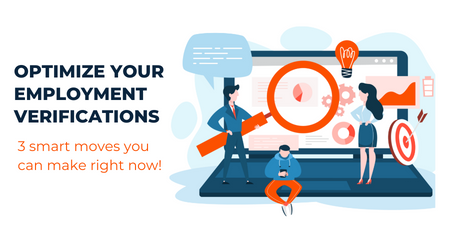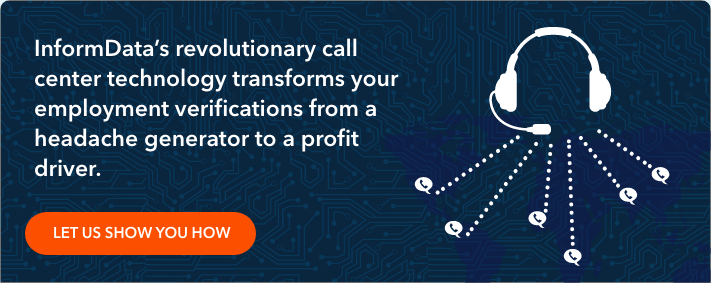What does a highly-optimized employment verifications process look like? For most CRAs and background screening companies, it comes down to the two metrics end-users care about the most: verification (or completion) rate and turnaround time.
In an era of rampant understaffing and fierce competition for qualified workers, employers want their verification orders completed quickly and accurately. A highly-optimized employment verifications process avoids the delays, backlogs, and verification failures that send end-users into the arms of competing CRAs.
If your background screening company’s turnaround times are lagging and your verification rates are sinking, there are at least three interrelated elements of the verifications process you can look to for making improvements. We’ll start here with the relatively low-hanging fruit before proceeding to more advanced (and costly) optimizations.
1. Clean up your data
It’s been said that employment verifications represent 10% of a CRA’s revenue but 90% of their headaches. A significant portion of those headaches come from poorly-completed paperwork, misunderstood instructions, and vague resumes.
For example:
- An applicant that worked at a temp agency lists the employer where they were placed, not the agency itself.
- An applicant enters a partial rather than an exact employment date (just the month or the year, for example).
- An applicant who worked for a nationwide chain fails to name the specific location.
Sloppy entries like these can muddy data and severely impact efficiency, sending researchers on wild goose chases with no results to show for them. Fortunately, a little preparation can go a long way toward cleaning up your verifications data.
The first step is ensuring your end-users have proper instructions on providing data. End-users, and their job applicants, can’t be expected to read your mind, after all.
But people are notoriously poor at following (or even reading) instructions. So, limiting opportunities for end-users and job applicants to make data-entry mistakes is crucial. Essential data points, such as a full phone number and address, should be required fields in your system to ensure completeness and consistency.
2. Upgrade your call center technology
Does this sound familiar? You call a source to verify someone’s employment, and then you call again, and again — no response. Only later do you discover this particular source verifies via fax. All you got for your calls and waiting was an elevated turnaround time and an unhappy customer.
Now imagine you were using an automated calling system with the ability to “learn” the preferences of individual sources. Such a system could have saved you days.
A typical verifications researcher working for a CRA might have to internalize dozens or even hundreds of rules concerning when to call particular sources for particular end-users, how often to call, and what to say.
The latest cutting-edge call center technology eliminates all that, letting system administrators set up complex calling rules that operate behind the scenes, routing calls to the right caller at the right time to maximize the chances of a positive response. From a caller’s perspective, one call is the same as the next; all the caller has to do is read a script off their screen. Dropdown menus prevent the conversation from wandering into freeform territory.
You can see how such a system could vastly improve your turnaround times and verification rates. You would no longer have to train your researchers on multiple calling procedures or segment them by client. This would give you the flexibility to take on more verifications work without sacrificing efficiency.
Best of all, a technology-driven calling system would generate mountains of data — data you could use to optimize your calling process even further. (For example, integrating the fact that a particular source prefers faxing.)
3. Streamline your training process
It can take anywhere from six to eight weeks for the typical CRA to get a new hire up to speed. During that period, the new hire must master the calling system and learn the various customizations required for different clients. Once they begin making calls, it can be several more weeks — or months — before the new hire is anywhere near full productivity.
The long, slow onboarding process is a chief reason many background screening companies struggle to adapt quickly to employment market shifts. Many CRAs were left understaffed and unprepared when the pandemic-related hiring standstill took off like a rocket as employers returned to business (and the Great Resignation took hold).
Working with the technology we described in the section above, CRAs can streamline their onboarding processes. For example, here at InformData, our training lasts four days. After that, new hires are ready to hit the phones. Within three weeks, new hires are at 75% productivity.
This is possible because our new hires are required to learn much less than the typical CRA’s new hires. Every call they make while performing employment verifications is scripted for them. All the documentation they need is available at the press of a button. Dropdown menus limit their choices. The system itself makes all the difficult decisions.
One advantage of an onboarding process such as InformData’s is that it allows for hiring many more part-time verification researchers. A team of part-time workers gives you the flexibility to schedule your team during the optimal calling hours.
Better results are within reach for CRAs of any size
Reading this, you might think, “Sure, advanced call center technology and a streamlined, technology-oriented training program would certainly help my background screening company achieve faster turnaround times and higher verification rates. But we don’t have the resources to invest in technology like that. Nor do we possess the institutional knowledge to configure it for optimal results.”
Fortunately, you don’t have to spend millions on upgrading your call center and revamping your training program to benefit from a highly-optimized employment verifications process. The solution is to partner with a data provider that has already made these investments (and is committed to continual improvements).
We’ll cover the advantages of outsourcing employment verifications in coming articles. Suffice it to say now, with the right employment verifications data partner on your side, a CRA of any size can transform employment verifications from a headache generator to a profit driver.



